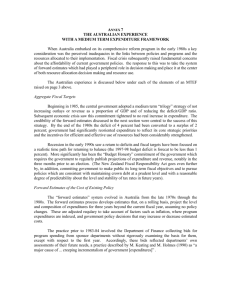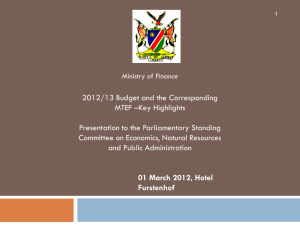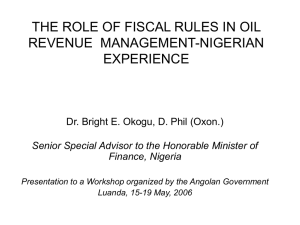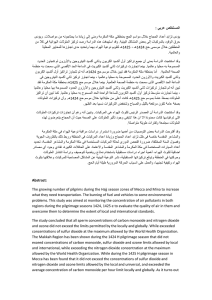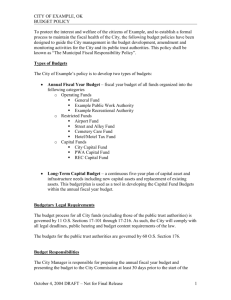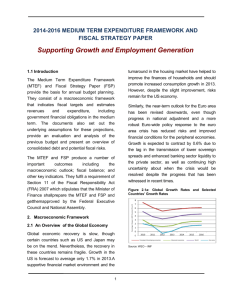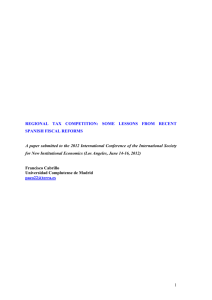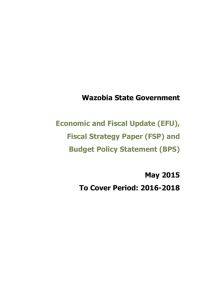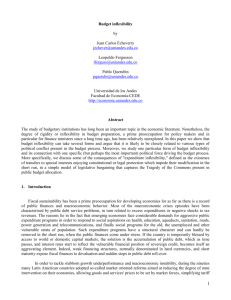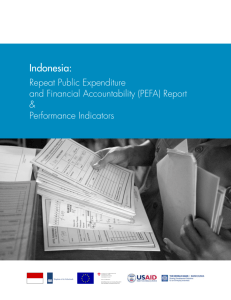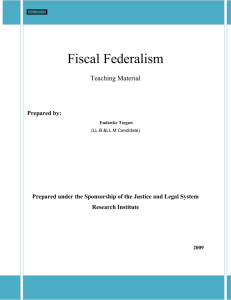statment details
advertisement
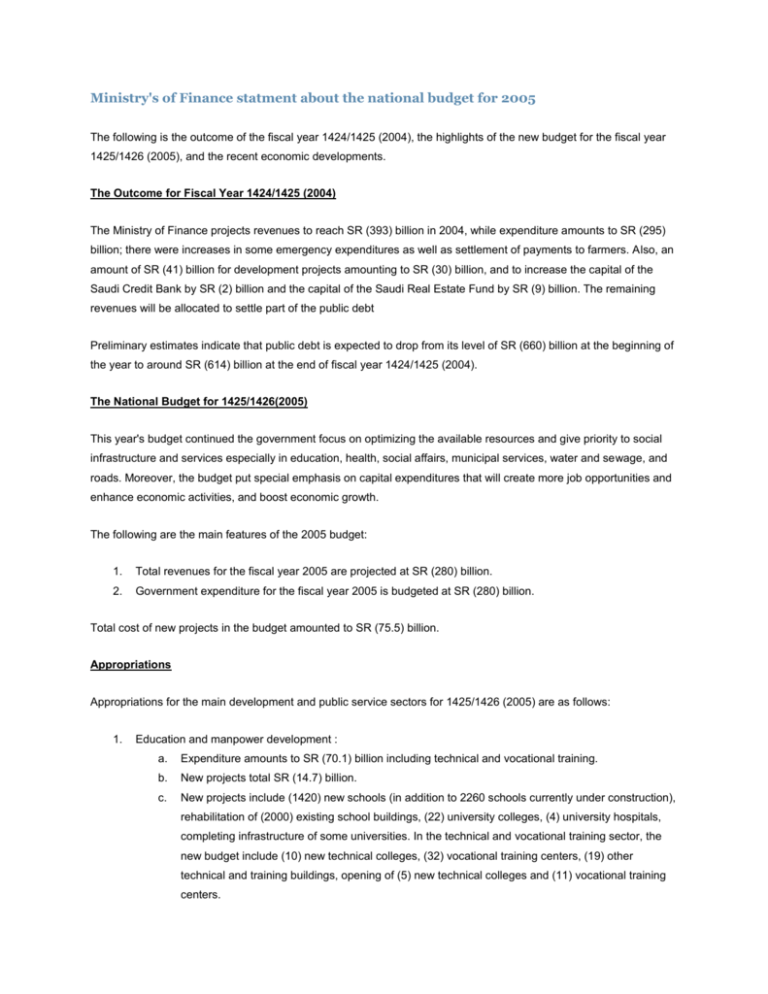
Ministry's of Finance statment about the national budget for 2005 The following is the outcome of the fiscal year 1424/1425 (2004), the highlights of the new budget for the fiscal year 1425/1426 (2005), and the recent economic developments. The Outcome for Fiscal Year 1424/1425 (2004) The Ministry of Finance projects revenues to reach SR (393) billion in 2004, while expenditure amounts to SR (295) billion; there were increases in some emergency expenditures as well as settlement of payments to farmers. Also, an amount of SR (41) billion for development projects amounting to SR (30) billion, and to increase the capital of the Saudi Credit Bank by SR (2) billion and the capital of the Saudi Real Estate Fund by SR (9) billion. The remaining revenues will be allocated to settle part of the public debt Preliminary estimates indicate that public debt is expected to drop from its level of SR (660) billion at the beginning of the year to around SR (614) billion at the end of fiscal year 1424/1425 (2004). The National Budget for 1425/1426(2005) This year's budget continued the government focus on optimizing the available resources and give priority to social infrastructure and services especially in education, health, social affairs, municipal services, water and sewage, and roads. Moreover, the budget put special emphasis on capital expenditures that will create more job opportunities and enhance economic activities, and boost economic growth. The following are the main features of the 2005 budget: 1. Total revenues for the fiscal year 2005 are projected at SR (280) billion. 2. Government expenditure for the fiscal year 2005 is budgeted at SR (280) billion. Total cost of new projects in the budget amounted to SR (75.5) billion. Appropriations Appropriations for the main development and public service sectors for 1425/1426 (2005) are as follows: 1. Education and manpower development : a. Expenditure amounts to SR (70.1) billion including technical and vocational training. b. New projects total SR (14.7) billion. c. New projects include (1420) new schools (in addition to 2260 schools currently under construction), rehabilitation of (2000) existing school buildings, (22) university colleges, (4) university hospitals, completing infrastructure of some universities. In the technical and vocational training sector, the new budget include (10) new technical colleges, (32) vocational training centers, (19) other technical and training buildings, opening of (5) new technical colleges and (11) vocational training centers. 2. Health and social Affairs : . Expenditure amounts to SR (27.1) billion. a. New projects total SR (4.6) billion. b. New projects include (420) primary care centers, (23) hospitals with a capacity of (3150) bed, expansion and development of existing health facilities, and furnishing newly completed hospitals. Meanwhile, there are (62) hospitals under construction which will add (7000) bed. 3. Municipality services: . Expenditure amounts to SR (10.7) billion. a. New projects total SR (7.2) billion. b. New projects include roads in cities and towns, intersection and bridges, road lights, and cleaningrelated projects. 4. Transportation and telecommunication : . Expenditure amounts to SR (8.9) billion. a. New projects total SR (8.4) billion. b. New projects include roads totaling (6700) km ( there are (10600) km of roads currently under construction ), ports, airports, and railroads development, first phase development of King Abdulaziz Airport in Jeddah, and new postal services. 5. Water, Agriculture, and Infrastructure Sector: . Expenditure amounts to SR (19.2) billion. a. New projects total SR (19.1) billion. b. New projects include water, sewage, and desalination projects amounting to SR (17.2) billion. In addition the budget includes projects in the two industrial cities of Jubail and Yanbu, agricultural projects, and flour mill projects. 6. Specialized Credit Development Institutions and Government financing programs As mentioned earlier, there will be an increase in the capital of Saudi Credit Bank and the Real Estate Development Fund to enable the two institutions to increase there lending programs. In addition, the other Specialized Development Institutions will continue to provide credits to projects and services in the areas of industry, agriculture, and major infrastructure projects. These credits are projected to be over SR (10) billion in year 2005. Also, the new budget includes appropriations for lending programs of private universities, colleges, and schools. Economic Developments in 2004 1. Gross Domestic Product GDP is estimated to grow in 2004 by (16.9) percent in current prices (((5.3)) percent in constant prices), reaching SR (931.8) billion. One of the major factors contributing to this growth is the increase in oil prices as well as the quantities produced. As a result, the oil sector is expected to grow by (28.2) percent in current prices Private sector GDP is estimated to grow by (6.7) percent in current prices and by (5.7) percent in constant prices. In particular and in real terms the non-oil industrial sector is estimated to grow by (6.4) percent, construction sector by (7.5) percent, electricity, gas, and water sector by (4.5) percent, and transport, communication sector by (7.8) percent, and wholesale, retail, restaurants, and hotels by (4.9) in constant prices. 2. General Price Level Inflation, as measured by the cost of living index, is estimated to have increased by (0.2) percent in 2004, while the non-oil GDP deflator has shown a small increase of (1) percent. 3. Balance of Payments According to SAMA preliminary data, current account is estimated to record a surplus amounting to SR (193.2) billion in 2004 compared to (105.2) billion in 2003. Non-oil exports are estimated to grow by (23.8) percent in 2004 totaling SR (51) billion, representing (11.3) percent of total exports. 4. Money and Banking The government fiscal financial and monetary policies continue to be guided by the objective of maintaining stability in price level and exchange rate. The broad money supply during the first ten months of 2004 grew by (9.6) percent compared to (4.2) percent in the same period of the pervious year. With regard to banking sector, Bank deposits recorded a growth of (10.1) percent during the first ten months of 2004, total banks claims on public and private sectors increased by (26.3) percent ; also their capital and reserves increased by (12.9) percent reaching SR (53.1) billion. 5. Other Developments A number of factors and developments have enhanced the confidence of the private sector leading to its robust growth. These include: a. The implementation of the capital market law after the appointment of the market authority board in July 2004. Its first operation was the approval of offering part of the shares of telecommunication Company (Ithad Itisalat), and (70) percent of the shares of the National Company for Cooperative Insurance will be sold to public before the end of the year. b. The (A+) long-term local currency and (A) long-term foreign currency sovereign credit rating assigned to the Kingdom by Standard & Poor's for the second year in a row. c. The (A) sovereign credit rating assigned to the Kingdom by Fitch in 2004. d. The stock market index continued to increase during 2004 closing at almost (7900) on 6/12/2004 compared to (4400) at the beginning of the year. e. New fiscal, institutional, and structural reforms have been introduced in 2004 such as the new corporate tax law, mining code, and the by-laws of natural gas pricing, the by-laws of the program for loan guarantees of small and medium enterprises (SME's), and the by-laws of private sector participation in electronic government activities. > f. Active participation of the private sector in the government procurement with the total number of government contracts signed with the private sector in 2004 amounted to (2850) contract with a value around SR (38) billion.

